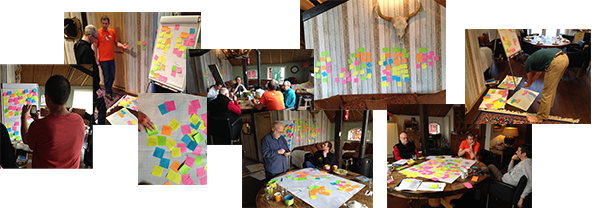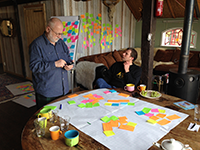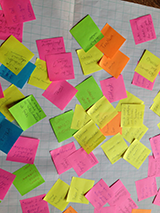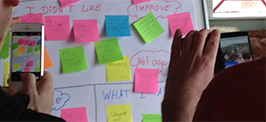The first EduPLoP is over and it was a great experience! It was friendly, highly productive and very creative! Our goal was to mine and write educational patterns, focusing on good assessment. In only three full days we have captured hundreds of experiences, started writing 24 patterns (using Google docs for collaborative writing), and identified another 11 patterns we want to write very soon. This will probably lead to 4-5 papers containing educational patterns.
One of the productive factors was the THE RIGHT PLACE. We chose a place in the Netherlands far away from the next village but with a beautiful area around. Hence, we had enough time for writing, discussing, outlining etc. without any distraction. Looking out of the window was relaxing (the storm quite chilling) and inspiring (to seek for the quality without a name). Cooking together and playing games was great for community building and intense discussions.
I was really amazed how well one important tool worked: STICKY NOTES. We had them everywhere (at the wall, the table, the flipchart), and we used them for many things: writing down expectations, educational forces, pattern ideas, examples, retrospections…
What worked out nicely was the use of large sheets of paper. We put those on the table to brainstorm good assessment strategies as a base for our later patterns. This process was inspired by Takashi Iba’s workshops on pattern mining. The large paper sheets made it possible to move whole topics or views from the table to the ground and vice versa. It was just amazing how much space our ideas literally occupied in the house!
What I like most about sticky notes:
- Everyone can use them – simplicity at its best!
- Re-arranging them is very quick.
- Notes can overlap, making information very dense.
- Spatial arrangements can be used for many meanings (relations, groups, headlines…).
- A block of sticky notes can always lay around, inviting you to write or sketch.
- Everyone can write at any time and many people can write at the same time.
Using paper sheets as backgrounds allowed us to
- Draw boundaries around groups
- Add headlines to sections
- Move groups of sticky notes around
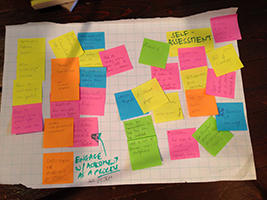
What I didn’t like (as compared to digital notes):
- We all made our photos of the sticky note walls. But do we really use them?
- To keep all notes, we copied them into Google Docs documents by typing manually. So we got all the text blocks but lost the structure. (Oh, and it did take some time to type…)
- Rearranging sticky notes means to loose old states. When you use digital tools such as SMART Meeting Pro or Lino it you can duplicate a page or board in order to save the current state. This lets you explore alternatives and return to previous layouts of sticky notes.
Well, I love sticky notes. So… we will have some thoughts on digital sticky note in the upcoming posts ![]()
COINS2015 was a great event in many ways. Takashi Iba told me about the conference last autumn while we were both at the PURPLSOC. As COINS2015 was planned to have many topics on patterns and innovation it was a natural fit to my interests. A very positive surprise to me, however, was the focus on network analysis to identify patterns of collaborative innovation (not design patterns). COINS was originally started by Peter Gloor, a research scientist of the Center for Collective Intelligence at the MIT. Peter’s workshop on the network analysis software Condor was a real spark for me to experiment with it in the next semester.
This is the great value of conferences that bring together an abundance of people with different backgrounds. The 15-minute presentations have been kick-starters for my interest and I will report on some of the topics in the next weeks as I dig deeper into them.
As I had my own paper on “Collaboration tools and patterns for creative thinking” it was time to review available tools and apps for creative thinking. I will post on valuable tools and how they relate to patterns of creative thinking in this blog.
Applying the Idea Quota pattern (learn about it in my next post) I am planning to have at least 5 posts a week. Let’s see whether I keep up to it. Thanks to my trip to Japan I have already a long list of things (or is that “thinks”) in my mind.

